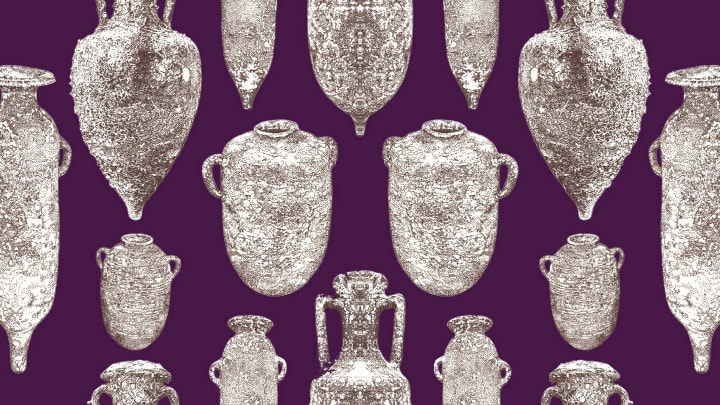Amphorae Amore: Modern Winemakers Are Bringing Back an Ancient Tradition

When ancient winemakers were ready to age their vino, they brought out the amphorae—multipurpose, narrow-necked clay containers with handles. The Phoenicians, one of the great trading powers 3000 years ago, stored wine as well as honey, milk, and olive oil in them, and amphorae containing wine residue were found in King Tutankhamen’s tomb. Traders in the Roman Empire used them to transport goods around the Mediterranean, and thanks to the clay containers' popularity and broad circulation, plenty of them can be uncovered around the globe today.
Now, some modern winemakers have begun experimenting with these ancient storage methods. They say that aging in amphorae can even elevate the terroir—the characteristics imparted to wine by the environment in which the grapes are grown. In the evolving world of wine, the use of amphorae is a callback to the past, anchoring modern wine drinkers to history.
Versatile Vessels
Recently, French and Italian researchers discovered new clues to how ancient Romans made and stored wine in amphorae, and how the vessels may have altered the drink’s flavor. The scientists examined the coatings of three amphorae dating from the 2nd and 1st centuries BCE, which had been recovered from the seabed about 50 miles southeast of Rome. Chemical analyses found that both red and white wines were stored in them and that they had been waterproofed with pine tar. Ancient winemakers used such resins to seal their vessels as well as to control bacteria—and the substance likely would have added an aromatic and herbal note to their wines.
The downsides of these ubiquitous containers were that they were heavy and breakable. Eventually, the Romans began using other storage methods, such as barrels, a technology they picked up from their settlements in Gaul (present-day France). The Gallic method of storing wine in barrels didn’t just make the vino easier to take back to Rome—it also gave the wine itself a different taste. The wood adds flavor compounds to wine, imparting notes that present as clove, vanilla, or chocolate aromas. So, while oak allows wine to age slowly and steadily and develop complex flavors, it also leaves its own mark.
Tinkering with Terroir
Some winemakers today are developing wines without those extra notes, while still using the ancient amphorae as their containers of choice. Vineyard manager and winemaker Gelert Hart, of AmByth Estate in Paso Robles, California, says amphorae are the perfect vessels to use if vintners want to allow the wine to breathe without manipulating flavor.
“For wine to correctly go through all the processes, it needs to have interaction with oxygen,” Hart tells Mental Floss. The large pores in the thick terracotta clay of the amphorae often allow more oxygen transfer than wooden barrels do, so “the wine condenses and vinifies over time to express the little nuances of terroir that would be covered and hidden with [a] vessel like oak, or not expressed enough in concrete or steel,” he says.
The amphorae’s clay structure thus exposes wine to oxygen to bring out flavors, but without imparting powerful tannins from the wood. Plus, as the clay interacts with enzymes in the wine, the wine’s pH is raised, elevating its bright acidity.
Amphorae have proven popular with biodynamic growers like Hart, as well as some organic winegrowers, because it gives their carefully cultivated grapes a chance to shine.
A Taste of History?
Would the wines of the ancients have been anything like today’s amphora-aged wines? It seems unlikely, since today’s amphorae are missing a key ingredient: They aren’t sealed with pine resin during the fermentation process. Leaving amphorae unsealed allows that tiny amount of oxygen in to the aging wine, bringing out its optimum flavor and character. “I have heard of amphorae lined with beeswax, but that completely defeats the purpose of [aging it this way],” Hart says. Without the resin, you won’t get those piney tones.
Curious oenophiles looking for a hint of the ancient flavor profile could seek out retsina. This Greek wine was originally stored in amphorae sealed with pine resin, which gave it a spicy note; today’s retsina is still flavored with the resin of Aleppo pine trees. The blend could provide a better idea of how wines aged in the ancient way may have tasted.
But in some cases, older winemaking routines might be best left in the past. In the 1990s, a historian recreated wine as it was made long ago, using a recipe from a 1st-century BCE text by Cato. It called for seawater to be placed in earthenware jugs prior to the fruit being added. This salinity helped to preserve wine, but made it undrinkably salty.
Even if today’s amphora-aged wines don’t taste quite like the wines of antiquity, experimental winemakers are blending history and modern knowledge to carry on the tradition.